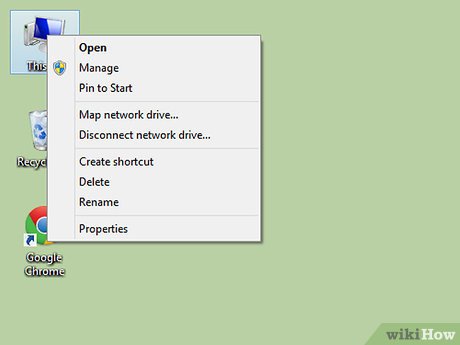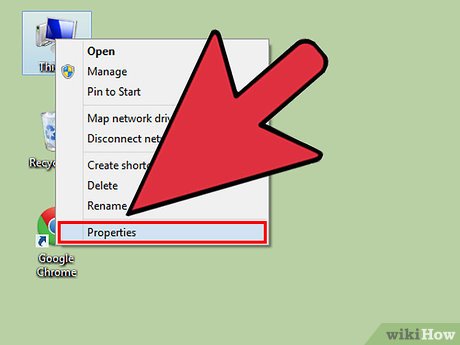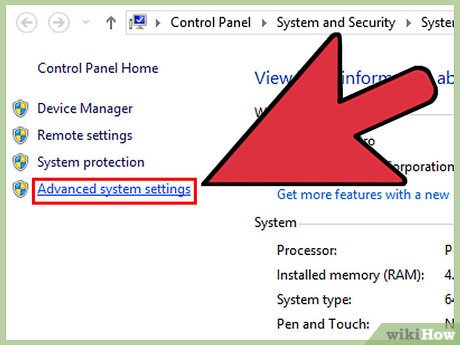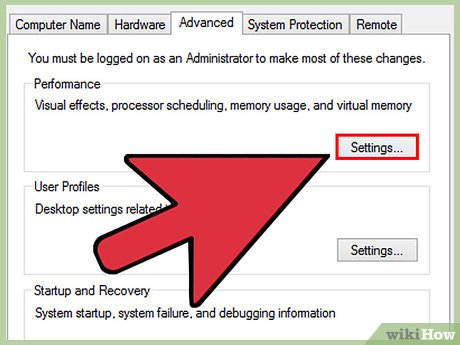How to Fix Windows 8.1 Lags
Method 1 of 4:
Optimize System Settings for Best Performance
-
 Right click the Computer icon on your Desktop.
Right click the Computer icon on your Desktop. -
 Select Properties from the context menu.
Select Properties from the context menu. -
 System page will open. Click "Advanced system settings" link.
System page will open. Click "Advanced system settings" link. -
 In the System Properties dialog box, click Settings button under Performance frame.
In the System Properties dialog box, click Settings button under Performance frame. -
 In the Visual Effects tab select "Adjust for best performance" option. Windows will automatically uncheck all the checkboxes.
In the Visual Effects tab select "Adjust for best performance" option. Windows will automatically uncheck all the checkboxes. -
 Click OK twice to save the settings and exit.
Click OK twice to save the settings and exit.
Method 2 of 4:
Optimize Drive Performance
-
 Press Windows Key + C simultaneously. This will open the Charms Bar.
Press Windows Key + C simultaneously. This will open the Charms Bar. -
 Click the Search icon.
Click the Search icon. -
 Type "optimize" in the Search Box.
Type "optimize" in the Search Box. -
 Click the Settings icon.
Click the Settings icon. -
 Open "Defragment and optimize your drives" from the Search Results page.
Open "Defragment and optimize your drives" from the Search Results page. -
 Optimize Drives application will list all the partitions in a list box. Select all the partitions, and then click the "Optimize" button.
Optimize Drives application will list all the partitions in a list box. Select all the partitions, and then click the "Optimize" button.- The process of defragmenting all drives will take several hours depending on the size of content stored on your your hard disk.
-
 Click the "Change Settings" button. While waiting for the defragmentation, you can set up an optimization schedule.
Click the "Change Settings" button. While waiting for the defragmentation, you can set up an optimization schedule. -
 Check the box named "Run on a schedule". Select the preferred frequency; for example, daily, weekly or monthly.
Check the box named "Run on a schedule". Select the preferred frequency; for example, daily, weekly or monthly. -
 Select all the partitions for scheduled defragmentation. Click the OK button.
Select all the partitions for scheduled defragmentation. Click the OK button. -
 Do not close the program until the defragmentation process is completed.
Do not close the program until the defragmentation process is completed.
Method 3 of 4:
Optimize System Startups & Services
-
 Press Windows Key + X simultaneously.
Press Windows Key + X simultaneously. -
 Click Task Manager.
Click Task Manager. -
 Click "More details' link.
Click "More details' link. -
 Click the Startup tab.
Click the Startup tab. -
 Click the "Status" column to sort all the startup programs in a state-wise manner.
Click the "Status" column to sort all the startup programs in a state-wise manner. -
 Disable all the Non-Microsoft programs except your Antivirus software. To disable an item, select it and click the Disable button.
Disable all the Non-Microsoft programs except your Antivirus software. To disable an item, select it and click the Disable button. -
 Click the Services tab.
Click the Services tab. -
 Stop all the Non-Microsoft services except those associated with your Antivirus. Right click a service name, select Stop option from the context menu.
Stop all the Non-Microsoft services except those associated with your Antivirus. Right click a service name, select Stop option from the context menu. -
 Press Esc to exit Task Manager.
Press Esc to exit Task Manager.
Method 4 of 4:
Clean the Hard Disk
-
 Double click the Computer icon.
Double click the Computer icon. -
 Right click a partition, for example, drive C:
Right click a partition, for example, drive C: -
 Select Properties from the right-click options menu.
Select Properties from the right-click options menu. -
 Drive Properties dialog will open. Click the Disk CleanUp button under General tab.
Drive Properties dialog will open. Click the Disk CleanUp button under General tab. -
 Disk CleanUp will start analyzing the free and used disk space.
Disk CleanUp will start analyzing the free and used disk space. -
 Check-up all the checkboxes and start the actual clean-up. The drive clean-up process may take several minutes.
Check-up all the checkboxes and start the actual clean-up. The drive clean-up process may take several minutes. -
 Repeat the procedure for remaining partitions of your hard disk.
Repeat the procedure for remaining partitions of your hard disk.
5 ★ | 1 Vote
































 How to Restart Windows 8
How to Restart Windows 8 How to Add a Printer to Windows 8
How to Add a Printer to Windows 8 How to Turn Off Windows Activation Messages in Windows 8
How to Turn Off Windows Activation Messages in Windows 8 How to Install Windows 8 from USB
How to Install Windows 8 from USB How to Set Up a Mic in Windows 8
How to Set Up a Mic in Windows 8 How to Use Remote Desktop on Windows 8
How to Use Remote Desktop on Windows 8